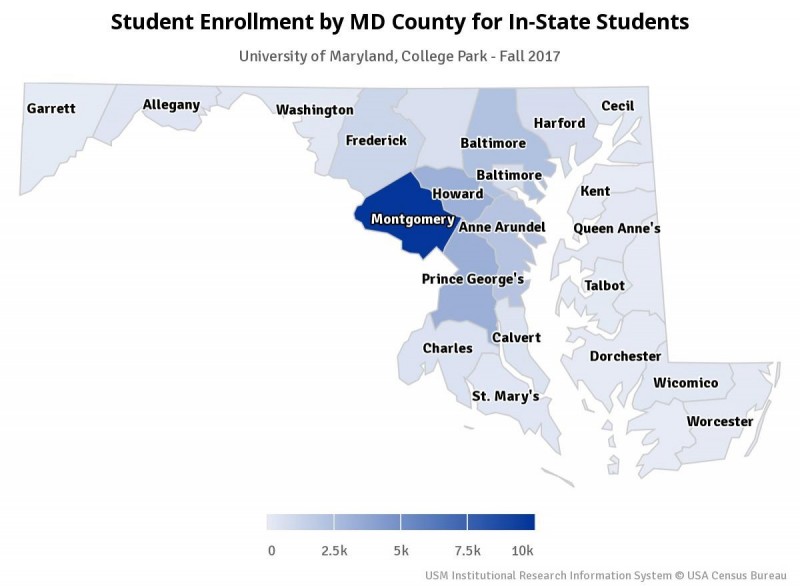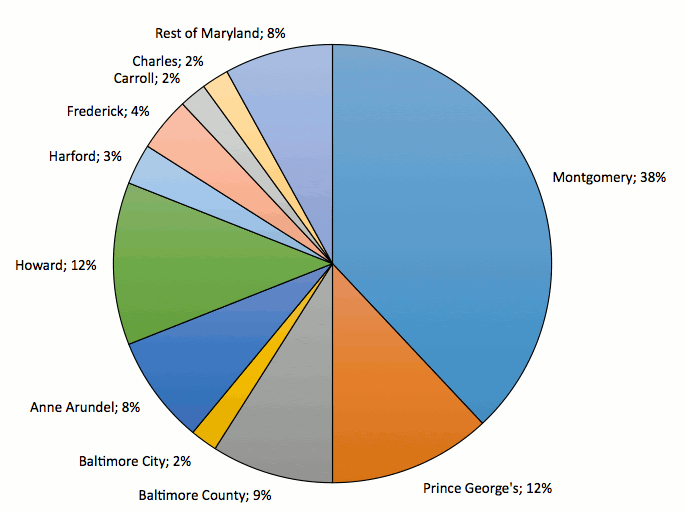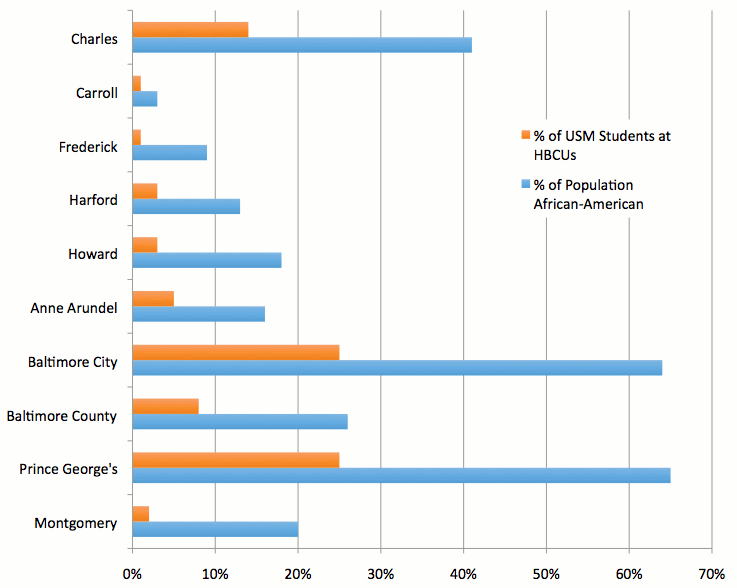Prince George’s sends fewer students to Maryland’s flagship university than other counties. Why?

A map of Maryland counties, showing how many students they send to the University of Maryland, College Park. Image by University System of Maryland Institutional Research Information System.
I recently discovered this portal where the University System of Maryland posts enrollment and other data; it includes all of Maryland's public four-year universities except for Morgan State University and St. Mary's College of Maryland, which are run independently.
While I haven't looked closely through all the data available — there is a lot of it — one thing jumped out to me: although the state's flagship university, the University of Maryland, College Park (UMCP), is located in Prince George's, the county sends significantly fewer students there as a fraction of its population than other area counties do.
Number of University of Maryland, College Park students per 100,000 residents from each of Maryland's ten largest counties. Image by the author.
In fall 2017, about 370 Prince George's County students per 100,000 residents enrolled in UMCP, compared to 1,050 Howard County students, 980 Montgomery County students, 470 Frederick County students, and 380 Howard County students.
Fraction of University of Maryland, College Park students from each of Maryland's ten largest counties. Image by the author.
Montgomery County supplies 38% of UMCP's in-state students, while Howard County and Prince George's County — with a much larger population than Howard County — supply 12% each.
Are Prince George's students choosing to go other colleges instead?
Unlike Montgomery County and Howard County, which have no public four-year universities (though Montgomery does have a classroom center where some upper-level classes are taught), Prince George's County has three public four-year schools: the University of Maryland, College Park; Bowie State University, a historically black school located in northern Bowie; and the University of Maryland, University College, which focuses heavily on online education but has its main academic campus in Largo.
Not entirely surprisingly, nearly three-quarters of Prince George's County's USM students go to school within the county: it sends 19% each to College Park and Bowie State and 36% to University College. On the other hand, Montgomery County sends 45% of its students going to University System of Maryland schools to College Park, and another 22% to University College, while Howard County sends 33% to College Park, 22% to University of Maryland, Baltimore County (the school closest to Howard County), and 18% to Towson University (north of Baltimore).
Percentage of University System of Maryland students from each of Maryland's ten largest counties attending each school in the system that enrolls undergrads. Image by the author.
As for why students are making these choices, it's less clear. However, it's worth noting that the University of Maryland, College Park has a higher acceptance rate than Bowie State (45% versus 36%), but a lower one than the University of Maryland, Baltimore County (60%).
Acceptance rates and yield ratios (the percentage of accepted students who choose to attend a school) for University System of Maryland schools other than the University of Maryland, University College, which has open admissions. Image by the author.
Knowing the acceptance rates for students from different counties, and their yield ratios (the fraction of admitted students who actually choose to attend a given school) would be useful for understanding this data better. Unfortunately, however, UMCP doesn't tabulate this data by county, so it is unavailable.
Are Prince George's County students preferring to go to HBCUs?
One factor that might lead to different college choices by residents of different counties is the existence of Historically Black Colleges and Universities (HBCUs). Three of the University System of Maryland's schools — Bowie State University, Coppin State University, and the University of Maryland, Eastern Shore — along with Morgan State University, which is a public school but not part of the USM, are HBCUs.
African-American percentage of county population and percentage of county University System of Maryland students at Historically Black Colleges and Universities, for each of Maryland's ten largest counties. Image by the author.
Unsurprisingly, the data does seem to suggest that counties with larger African-American populations send more students to HBCUs, although the degree to which is the case varies by county. The fraction of USM students from Prince George's County, Baltimore City, Baltimore County, Charles County, Carrol County, and Anne Arundel County attending HBCUs is about one third of the fraction of those counties' populations that are African-American.
On the other hand, the equivalent fraction is one-sixth for Howard County and one-tenth for Montgomery County. That these counties send less students than expected to HBCUs is likely related to the fact that they send more students than expected to the University of Maryland, College Park, though it is not clear why African-American students from these counties would be less likely to choose HBCUs than African-American students from elsewhere in the state.
Are transfers from community colleges relevant?
Another matter to keep in mind is that not all students choose to go directly to a four-year college. Many start at a two-year community college first to get their general education requirements out of the way more cheaply, and sometimes to strengthen their application to the four-year college they want to eventually attend.
According to Maryland Department of Education reports, the ratio of students going to two-year versus four-year colleges immediately after high school from Prince George's, Howard, and Montgomery Counties is about the same: half as many go to two-year as four-year schools. The ratio is slightly higher in Prince George's, but not as high as in Calvert and Charles Counties, where 40% of college-bound students go to two-year schools and 60% to four-year schools.
African-American percentage of county population and percentage of county University System of Maryland students at Historically Black Colleges and Universities, for each of Maryland's ten largest counties. Image by the author.
While Maryland residents can attend any community college in the state at in-state rates, they get lower in-county rates if they attend their county's college. And, since community colleges are non-residential, there is a strong incentive for them to attend a college near home. Given this, it is notable that local community colleges have very different four-year schools they tend to send their students to.
Data from the University System of Maryland shows that roughly 35% of Montgomery College students who transfer to a system college transfer to the University of Maryland, College Park, while another 25% transfer to University of Maryland, University College, and just over 10% each transfer to Towson and University of Maryland, Baltimore County.
Percentage of University System of Maryland transfer students from Montgomery College who transfer to each school in the system. Image by the author.
Howard Community College has a similar distribution of schools its students transfer to, but with a larger fraction going to Baltimore-area schools: 20% to College Park, 22% to the University of Maryland, Baltimore County, and 20% to Towson University.
Percentage of University System of Maryland transfer students from Howard Community College who transfer to each school in the system. Image by the author.
On the other hand, Prince George's Community College sends just over half of its transfer students to University System of Maryland schools to the mostly-online University of Maryland, University college, while Howard Community College and Montgomery College send about a quarter each of their students there. On the other hand, Prince George's Community College sends 19% of its transfer students to Bowie State, which receives 2% of transfers from the other two schools, and only 13% to College Park.
Percentage of University System of Maryland transfer students from Prince George's Community College who transfer to each school in the system. Image by the author.
It's possible that these differences are due to differences in the community colleges and their curricula — perhaps PGCC prepares students better for online coursework, or perhaps its academic advisors tend to push transfer students toward different schools — but it's also possible that these differences are produced by the same forces that are responsible for the differences in four-year college choices among students who don't attend a community college first.
High tuition costs could be an issue
It's important to keep in mind that tuition plays a major role in determining where students will apply to college, and which schools they will actually attend. Since Prince George's County is, on average, poorer than neighboring counties in Maryland and has a substantial low-income population, one explanation for the low number of Prince George's students attending the state's flagship university might be finances.
For the 2017-2018 school year, UMCP's undergraduate in-state tuition was $10,400, in comparison to $11,500 at UMBC, $8,100 at Bowie State University, and $6,800 at UMUC. These differences are significant enough that they could be playing a role in directing more Prince George's County students to the cheaper schools.
Furthermore, the fact that UMUC offers most of its classes online likely makes it more appealing to students who have to work while studying.
How do Prince George's public schools compare to other nearby systems?
Another issue is that Prince George's Public Schools' graduating seniors do less well on the SAT and other criteria used for college admission than students from other Maryland school systems.
Graduating PGCPS seniors who took the SAT in 2017 had an average score of 961, compared to 1127 for Montgomery County, 1161 for Howard County, 1106 for Calverty County, 1021 for Charles County, and 1071 for Anne Arundel County public school students. On the other hand, this is still better than DC Public School students, who had an average SAT score of 899.
While this data sugests that the average graduate of the Prince George's County public school system will have a somewhat lower chance of getting into selective colleges (such as the University of Maryland) than students from some neighboring counties, it doesn't suffice to explain the situation.
Readers: tell us about your experience!
